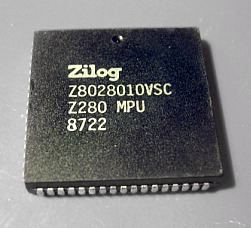 | ||
The Zilog Z280 was a 16-bit microprocessor, an enhancement of the Zilog Z80 architecture, introduced in July 1987. It was basically the Z800, renamed, with slight improvements such as being fabricated in CMOS. It was a commercial failure. Zilog added a memory management unit (MMU) to expand the addressing range to 16 MB, features for multitasking and multiprocessor and coprocessor configurations, a 256 byte cache, and a huge number of new instructions and addressing modes (giving a total of over 2000 combinations). Its internal clock signal can be configured to run at 1, 2 or 4 times the external clock's speed (e.g. a 12MHz CPU with a 3 MHz bus). More successful extensions of the Z80-architecture include Hitachi HD64180 in 1986 and Zilog eZ80 in 2001, among others. See further Zilog Z800.
The Z280 had many advanced features for its time, most of them never seen again on a Zilog processor:
